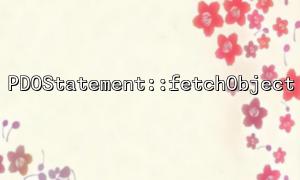In PHP, PDO (PHP Data Objects) provides us with a flexible database operation interface. Through the PDOStatement::fetchObject function, we can directly map the query results into objects. Combining prepare and execute methods can make our code more efficient and secure, especially when we deal with complex SQL queries. In this article, we will explore how to use the PDOStatement::fetchObject function efficiently, and techniques for making and execute methods.
The PDOStatement::fetchObject function is used to obtain a row of data from the query result and convert the row of data into an object. Unlike the fetch method in the form of an array, fetchObject allows us to access fields in the query results directly as an object.
For example, if the query result returns the following data:
| id | name | |
|---|---|---|
| 1 | Alice | [email protected] |
| 2 | Bob | [email protected] |
We can access data through fetchObject :
<?php
$stmt = $pdo->query("SELECT * FROM users");
while ($user = $stmt->fetchObject()) {
echo $user->id . ' - ' . $user->name . ' - ' . $user->email . '<br>';
}
?>
In this way, the query results are directly mapped to user objects, and the fields can be accessed directly through object properties.
Using prepare and execute can effectively prevent SQL injection and improve performance when multiple similar queries are required. The prepare function is used to preprocess SQL statements, and execute is used to execute this preprocessed statement.
For example, if we need to query user information by username, the traditional practice might be to splice strings directly, but this can lead to the risk of SQL injection. Use prepare and execute to solve this problem:
<?php
$sql = "SELECT * FROM users WHERE name = :name";
$stmt = $pdo->prepare($sql);
$stmt->execute([':name' => 'Alice']);
$user = $stmt->fetchObject();
echo $user->id . ' - ' . $user->name . ' - ' . $user->email . '<br>';
?>
In this example, :name is a named placeholder that will be replaced by the actual value (such as Alice ) when executed . This avoids the SQL injection problem.
When you need to deal with multiple variables, using named placeholders is more readable and maintainable than question mark placeholders. Named placeholders make SQL statements easier to understand and also facilitate matching variables when executed .
$sql = "SELECT * FROM users WHERE name = :name AND email = :email";
$stmt = $pdo->prepare($sql);
$stmt->execute([':name' => 'Alice', ':email' => '[email protected]']);
$user = $stmt->fetchObject();
echo $user->id . ' - ' . $user->name . ' - ' . $user->email . '<br>';
When executing execute , the parameter values can be bound by passing an associative array. This makes the code clearer and ensures the correctness of the parameter order.
$params = [
':name' => 'Alice',
':email' => '[email protected]'
];
$stmt = $pdo->prepare("SELECT * FROM users WHERE name = :name AND email = :email");
$stmt->execute($params);
$user = $stmt->fetchObject();
echo $user->id . ' - ' . $user->name . ' - ' . $user->email . '<br>';
During development, if you encounter problems, you can use debugDumpParams to debug SQL statements. This can help you check whether the SQL statement is built correctly and view the bound parameter values.
$stmt = $pdo->prepare("SELECT * FROM users WHERE name = :name");
$stmt->execute([':name' => 'Alice']);
$stmt->debugDumpParams(); // Output SQL Statement and binding parameters
$user = $stmt->fetchObject();
fetchObject maps query results to stdClass objects by default. But you can also map the results to a custom class. For example, if you have a User class, you can do this:
class User {
public $id;
public $name;
public $email;
}
$sql = "SELECT * FROM users WHERE name = :name";
$stmt = $pdo->prepare($sql);
$stmt->execute([':name' => 'Alice']);
$user = $stmt->fetchObject('User');
echo $user->id . ' - ' . $user->name . ' - ' . $user->email . '<br>';
In this way, the result will be mapped to an instance of the User class, not just a normal object.
Using PDOStatement::fetchObject and prepare and execute functions, we can efficiently and securely execute database query operations. Using named placeholders and associative arrays can improve the readability and maintainability of your code. During the development process, the rational use of debugging functions can also help us quickly locate problems. With these tips, you can operate the database more efficiently and ensure the security and readability of your code.
Related Tags:
PDOStatement














